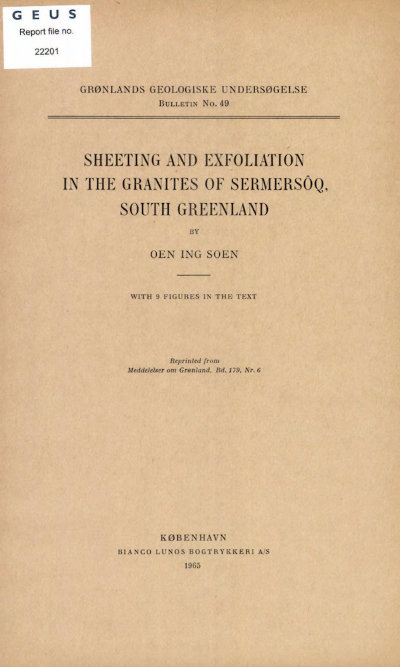Sheeting and exfoliation in the granites of Sermersôq, South Greenland
DOI:
https://doi.org/10.34194/bullggu.v49.6583Abstract
A study of sheeting structures in post-tectonic granites on the island of Sermersôq indicates that: 1) sheeting in the Precambrian granites of Sermersôq occurred mainly, if not exclusively, at the end of a second glacial stage on that island, i. e. during the Pleistocene; 2) this recent large-scale sheeting must have occurred spontaneously in a geologically speaking very short time interval; 3) there is no relation between the recent sheeting at a niveau immediately below the high-level erosion surface on Sermersôq and the removal of rock load above this surface by erosion; the latter erosion surface was formed in pre-Tertiary, Mesozoic or possibly Paleozoic times; 4) there are no relations between sheeting and primary structures in the granite; 5) the relation between sheeting and the most recent glacial geomorphological forms is very conspicuous; 6) sheeting has affected granites which were free or very poor in pre-existing open joints; the majority of all types of joints in the relevant granites were not opened before the period of spontaneous sheeting; 7) the cause of sheeting cannot be exclusively attributed to textural or compositional characteristics of the rocks; 8) sheeted granites in recently deglaciated areas may represent an early stage in the process of granite disintegration, which tends to the formation of a mature granite landscape with typical woolsacks and/or spheroidally exfoliated boulders. A review of the literature indicates that the following relations exist: a) large-scale deep sheeting, widespread exfoliation of boulders, and woolsacks are frequently associated phenomena characteristic of post-tectonic granites; the same combination of phenomena may occur in other rock types only when spatially associated with post-tectonic granite massifs; b) large-scale sheeting in granite areas is commonly preceded by regional uplift. A general inquiry into the cause and origin of sheeting and exfoliation leads to the following conclusions: Insolation, weathering, climatological conditions, textural and compositional properties of the rocks are secondary factors in causing the large-scale sheeting of rocks. Dilatation subsequent to release of pressures is the main cause of sheeting and exfoliation. However, the compressive pressures are not mainly due to overlying rock loads and the release of pressures is not exclusively or mainly due to the removal of superincumbent rock load by erosion. The inadequacy of the current "load pressures and relief of load by erosion" hypothesis is discussed especially with regard to conditions on Sermersôq. Large-scale sheeting and widespread exfoliation are related to an inherent property of post-tectonic granite massifs. Due to the mass deficiency represented by these massifs, gravitational body forces tending to raise the deficient masses above their surroundings originate, and during longer times these forces keep exerting an axial compression on the higher levels of the granites and the overlying or immediately adjoining country rocks. During epeirogenic uplift the vertically working forces are temporarily augmented by the epeirogenic forces, while subsequently the actual elevation of the area and the contemporaneous updoming of the granites tend to compensate the existing gravitational anomalies and to reduce the gravitational body forces. Thus, when regional uplift ceases or slows down temporarily, a relative decompression of the combined gravitational and epeirogenic forces occurs rapidly, which enables the rocks near the surface to exfoliate spontaneously by dilatation in a direction normal to the free surface or topography.
Downloads
Published
Issue
Section
License
This article is distributed under a CC-BY 4.0 licence, permitting free redistribution and reproduction for any purpose, even commercial, provided proper citation of the original work. Author(s) retain copyright over the article contents.


